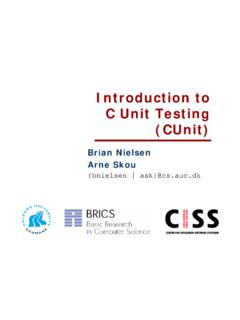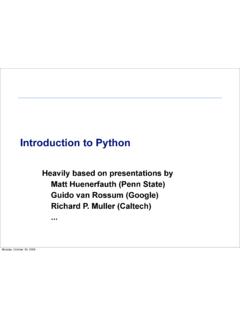Transcription of Introduction to Object-Oriented Programming
1 OOP: Introduction1 Introduction to Object-Oriented Programming Objects and classes Abstract Data Types (ADT) Encapsulation and information hiding Aggregation Inheritance and polymorphismOOP: Introduction2 Pure Object-Oriented LanguagesFive rules [Source: Alan Kay]: Everything in an object . A program is a set of objects telling each other what to do by sending messages. Each object has its own memory (made up by other objects). Every object has a type. All objects of a specific type can receive the same breaks some of these rules in the name of : Introduction3 The object Concept An object is an encapsulation of data. An object has identity (a unique reference), state, also called characteristics behavior An object is an instance of an abstract data type. An abstract data type is implemented via a : Introduction4 Abstract Data Type (ADT) An ADT is a collection of objects (or values) and a corresponding set of methods.
2 An ADT encapsulates the data representation and makes data access possible at a higher level of abstraction. Example 1: A set of vehicles with operations for starting, stopping, driving, get km/liter, Example 2: A time interval, start time, end time, duration, overlapping intervals, : Introduction5 Encapsulation and Information Hiding Data can be encapsulated such that it is invisible to the "outside world". Data can only be accessed via messageOOP: Introduction6 Encapsulation and Information Hiding, cont. What the "outside world" cannot see it cannot depend on! The object is a "fire-wall" between the object and the "outside world". The hidden data and methods can be changed without affecting the "outside world".Hidden data and methodsClient interfaceVisible data and methodsAn objectOOP: Introduction7 Class vs. ObjectClass A description of the common properties of a set of objects. A concept. A class is a part of a program.
3 Example 1: Person Example 2: AlbumObject A representation of the properties of a single instance. A phenomenon. An object is part of data and a program execution. Example 1: Bill Clinton, Bono, Viggo Jensen. Example 2: A Hard Day's Night, Joshua Tree, Rickie Lee : Introduction8 Type and Interface An object has type and an balance() withdraw() deposit()TypeInterface To get an objectAccount a = new Account() To send a ()OOP: Introduction9 Instantiating Classes An instantiation is a mechanism where objects are created from a class. Always involves storage allocation for the object . A mechanism where objects are given an initial state. Static Instantiating In the declaration part of a program. A static instance is implicitly createdDynamic Instantiating In the method part of a program. A dynamic instance is created explicitly with a special : Introduction10 Interaction between Objects Interaction between objects happens by messages being send.
4 A message activates a method on the calling object . An object O1 interacts with another object O2 by calling a method on O2 (must be part of the client interface). O1 sends O2 a message O1 and O2 must be related to communicate. The call of a method corresponds to a procedure call in a non- Object-Oriented language such as C or : Introduction11 Phenomenon and Concept A phenomenon is a thing in the real world that has individual existence. A concept is a generalization, derived from a set of phenomena and based on the common properties of these phenomena. Characteristics of a concept A name Intension, the set of properties of the phenomenon Extension, the set of phenomena covered by the : Introduction12 Classification and Exemplification A classification is a description of which phenomena that belongs to a concept. An exemplification is a phenomenon that covers the conceptConceptPhenomenonclassificationex emplificationOOP: Introduction13 Aggregation and Decomposition An aggregation consists of a number of (sub-)concepts which collectively is considered a new concept.
5 A decomposition splits a single concept into a number of (sub-) : Introduction14 Aggregation and Decomposition, Example Idea: make new objects by combining existing objects. Reusing the implementation!Carstart()drive()EngineGe arboxDoors[4]Enginestart()stop()Gearboxu p()down()Dooropen()close()new classexisting classesOOP: Introduction15 Generalization and Specialization Generalization creates a concept with a broader scope. Specialization creates a concept with a narrower scope. Reusing the interface!Concept AConcept BspecializationConcept CConcept DgeneralizationVehicleCarTruckHatchbackS tation carSedanPickupOOP: Introduction16 Generalization and Specialization, Example Inheritance: get the interface from the general class. Objects related by inheritance are all of the same type. Shape draw() resize()Circle draw() resize()Line draw() resize()Rectangle draw() resize()Square draw() resize()OOP: Introduction17 Code Example Polymorphism: One piece of code works with all shape objects.
6 Dynamic binding: How polymorphism is doSomething(Shape s){ (); // magically calls on specific class ();}Circle c = new Circle();Line l = new Line();Rectangle r = new Rectangle();doSomething(c);// dynamic bindingdoSomething(l);doSomething(r);OOP : Introduction18 Structuring by Program or Data? What are the actions of the program vs. which data does the program act on. Top-down: Stepwise program refinement Bottom-up: Focus on the stable data parts then add methods Object-Oriented Programming is bottom-up. Programs are structure with outset in the data. C and Pascal programs are typically implemented in a more top-down : Introduction19 Java Program Structuremethod bodymethod header// comment on the classpublic class MyProg { String s = Viggo ; /** * The main method (comment on method) */ public static void main (String[] args){ // just write some stuff ("Hello World"); }}variableOOP: Introduction20 Java Class Example Car/** A simple class modeling a car.
7 */public class Car { // instance variables private String make; private String model; private double price; // String representation of the car public Car(String m, String mo, double p) { make = m; model = mo; price = p; } // String representation of the car public String toString() { return "make: " + make + " model: " + model + " price: " + price; }}OOP: Introduction21 Byte Code vs. Virtual MachineOperating SystemJava Class Byte SystemExecutable : Introduction22 History of Java 1990 Oak (interactive television, big failure) 1994 Java (for the Internet) Main feature: "Write Once, Run Any Where" => wrap the operating system so they all look the sameDesigned for A fresh start (no backward compatibility) "Pure" OOP: C++ Syntax, Smalltalk style Improvements over C++ much harder to write a bad program Internet Programming Very hard to create a virus Run in a web browser (and at the server) There is a speed issue (from Java and up much better)OOP: Introduction23 Difference from C/C++ Everything resides in a class variables and methods Garbage collection Error and exception handling handling No global variables or methods No local static variables No separation of declaration and implementation (no header files).
8 No explicit pointer operations (uses references) No preprocessor (but something similar) Has fewer "dark corners" Has a much larger standard libraryOOP: Introduction24 Summary Classes are "recipes" for creating objects All objects are instances of classes An ADT is implemented in a class Aggregation and decomposition has-a relationship Generalization and specialization is-a or is-like-a relationship Encapsulation Key feature of Object-Oriented Programming Separation of interface from implementation It is not possible to access the private parts of an object








